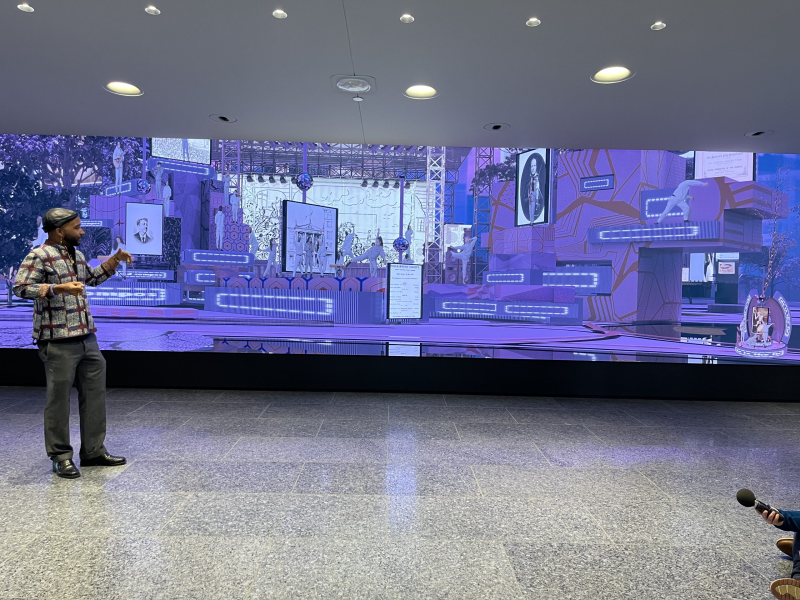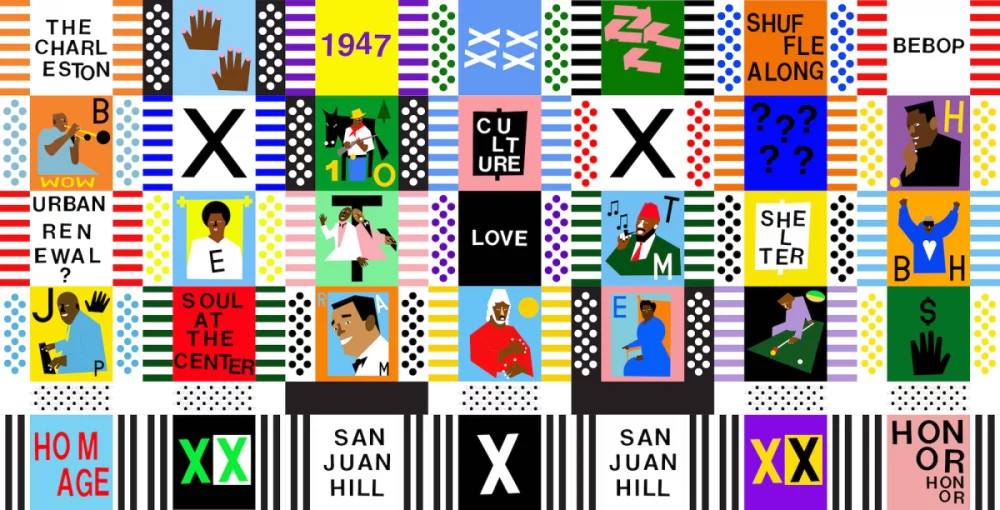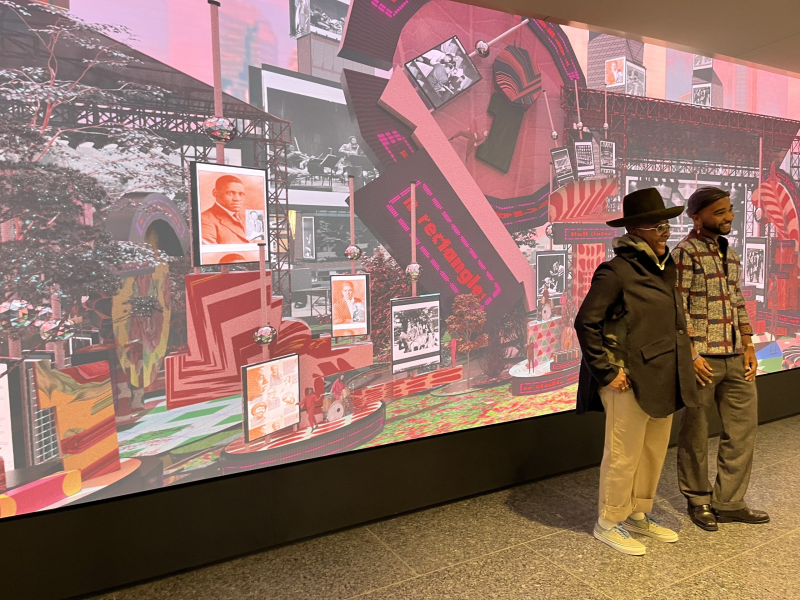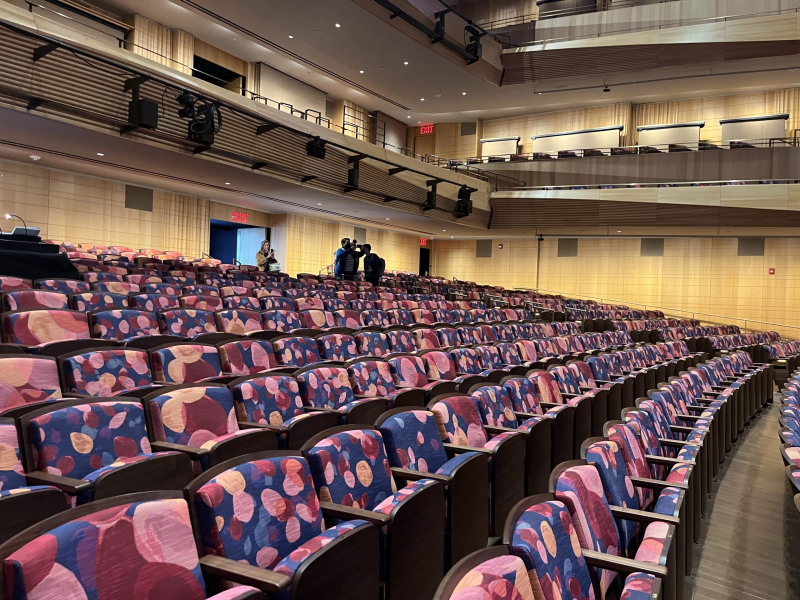
- Source: HYPERALLERGIC
- Author: JASMINE LIU
- Date: OCTOBER 10, 2022
- Format: ONLINE
Two Art Commissions Look at Lincoln Center’s History Anew
Nina Chanel Abney and Jacolby Satterwhite’s works for David Geffen Hall remember the vibrant history of the neighborhood.

Nina Chanel Abney’s “San Juan Heal” (2022) honors the vitality of the San Juan Hill neighborhood. (photo by Jasmine Liu/Hyperallergic)
Two new public art commissions unveiled at the long-awaited opening of David Geffen Hall on Saturday, October 8 served as public statements of intention for the new home of the New York Philharmonic — heralding what Lincoln Center hopes will be a vibrant, diverse future for the concert space.
Lincoln Center, which does not typically work with visual artists, partnered with the Studio Museum in Harlem and the nonprofit Public Art Fund to commission two pieces by Nina Chanel Abney and Jacolby Satterwhite. They will be displayed for 18 months before being replaced by new commissions.

Jacolby Satterwhite’s “An Eclectic Dance to the Music of Time” is a monumental work of digital art that occupies the 50-foot media wall in the lobby. (photo Jasmine Liu/Hyperallergic)
Blanketing the northern face of the new hall facing Alice Tully Hall is Nina Chanel Abney’s “San Juan Heal” (2022). Both the title and the work keep the memory of San Juan Hill alive, the predominantly Black and Puerto Rican neighborhood that once thrived where Lincoln Center now stands. San Juan Hill housed working-class families and incubated jazz musicians and Broadway talent alike in the first half of the 20th century. But in 1956, Robert Moses, who deemed San Juan Hill “the worst slum in New York,” decided that it would be razed and replaced with a performing arts center funded by Standard Oil heir John D. Rockefeller III. Thousands of residents were displaced in the process.

Nina Chanel Abney, “San Juan Heal” (2022) (photo by Nicholas Knight; courtesy Lincoln Center, Studio Museum in Harlem, and Public Art Fund)
On Saturday, Abney highlighted two particular patches in her quilt: one at center-right showing jazz pianist and composer Thelonious Monk, and another to its right illustrating explorer Barbara Hillary, the first Black woman to reach both the North and South Poles. Both Monk and Hillary — along with every other figure included in the tapestry — lived at some point in San Juan Hill. The cells also include keywords like “shelter,” citing “shelter before culture” signs demonstrators once toted to protest against Lincoln Center’s proposed construction, and more ambiguous “X” iconography that alludes perhaps to a forgotten past.

Nina Chanel Abney and Jacolby Satterwhite pose in front of the 50-foot media wall in the lobby of the new hall. (photo Jasmine Liu/Hyperallergic)
The second commission is a 27-minute video designed for a 50-foot-long media wall in the lobby, exploring a utopian landscape where New York City’s past and future meld to produce a more equitable and vital vision of artistic life. The video will be on display whenever the media wall is not being used to livestream performances taking place within the hall.
“I wanted to figure out how to make a digital quilt inside this landscape inspired by Central Park, to be a love letter to New York and its creative output,” said artist Jacolby Satterwhite. The digital piece, titled “An Eclectic Dance to the Music of Time,” features 120 dancers and musicians from the city’s performing arts schools, personally choreographed by the artist. They dance on platforms and outdoor stages set against an imaginary backdrop of sculptures, foliage, and skyscrapers. “What would it be like to allow them to see themselves as future performers of the Philharmonic in Lincoln Center?” Satterwhite posed on Saturday.
Also woven into the terrain are archival snippets and photographs of Black, women, and LGBTQ+ musicians and artists who were a part of the New York Philharmonic and Lincoln Center’s storied legacy, from 1842 to the present. Shanta Thake, chief artistic officer at Lincoln Center, told Hyperallergic that the institution offered both Abney and Satterwhite unrestricted access to its archives. “We encouraged their curiosity in digging into the archives, and said, ‘whatever you’re curious about, follow that path. We’re not going to stand in the way,’” she said. She praised Satterwhite for the artists he discovered whose histories with the center have not been highlighted as often.
The visual complexity of the work, Satterwhite admitted, was matched by technical challenges. “I had to basically rewrite code and rewrite software with technicians in order to figure out how to create a Hieronymus Bosch in a 21st century kind of display,” he explained.

The rose petal design on seats in the hall matches a design on the wall outside. (photo by Jasmine Liu/Hyperallergic)
The Geffen Hall retains its architectural exterior, designed by Max Abramovitz and first opened in 1962. The hall’s $550 million redesign was undertaken in large part to remedy the prior one’s notorious acoustic problems, and the new hall is smaller, with an added coffee shop, restaurant, welcome area, and sidewalk studio for community events. One aesthetic feature that particularly disarmed visitors on Saturday was the matching rose petal design that decorated both the outer walls of the theater and the seats inside. “Who would think to match the seats and the walls inside?” Senate Majority Leader Chuck Schumer said smilingly to the lead architect on the project Tod Williams as he filed out of the hall.
“I’m incredibly humbled to be able to create this public artwork that people can have family reunions in front of, and for people to propose to each other in front of, and to have human experiences in front of,” Satterwhite said. “Art is about being adjacent to human experience, and having a synesthesia with that.”

